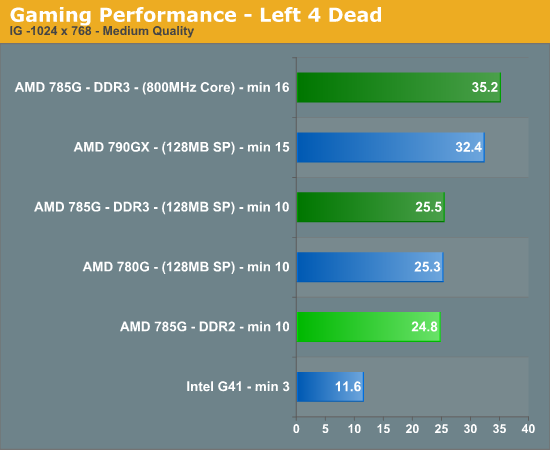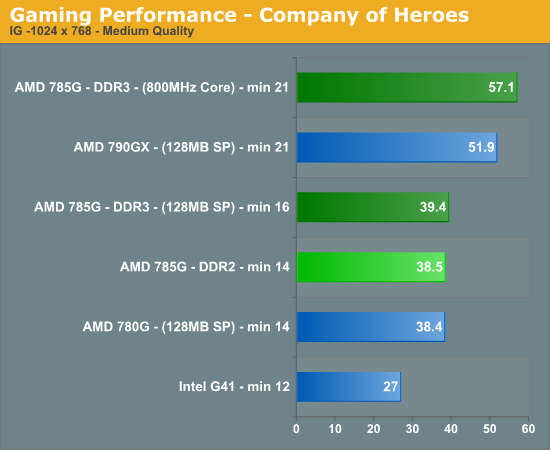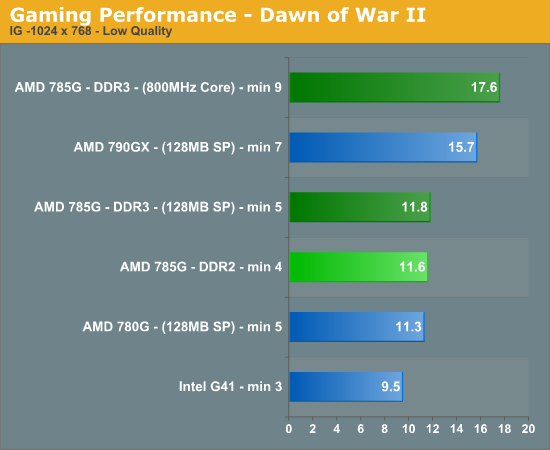AMD's 785G Chipset - Revolutionary or Evolutionary?
by Gary Key on August 4, 2009 5:00 AM EST- Posted in
- Motherboards
We set our game resolutions to 1024x768 with either medium or low quality settings. All of our 785G boards at this point have been able to run the graphics core at 800MHz without any voltage tweaks so we settled on that speed for comparison results. The 790GX runs its core at 700MHz for comparison.
We might as well get this out of the way, do not plan on running any titles other than Peggle or Plants versus Zombies on the G41 unless you reduce resolutions to 800x600 or less if the game allows it. Speaking of Plants versus Zombies, every IG solution here ran the game on maximum settings at the 60FPS rate limit. We tried Ghostbusters and the G41 averaged 11FPS at 1024x768 on low quality settings while the 785G averaged 20FPS. The game was not playable in our opinion on either platform. We are testing other titles for the motherboard roundup.
Left 4 Dead
This game is a blast and addictive to boot - provided you like killing hundreds of zombies while trying to take care of your teammates and sustaining high blood pressure rates. We enable all options, set AA to 2x and AF to 8x, and play back a custom demo of a game session from the Runway Finale chapter within the Dead Air campaign.

This game was actually playable on the 790GX and 785G with the graphics core speed increased to 800MHz. Just like the game’s title, the G41 was Left 4 Dead in our first test.
Company of Heroes: Tales of Valor
The oldest title in our test suite is still the most played. CoH has aged like fine wine and we still find it to be one of the best RTS games on the market. We crank all the options up to their highest settings, enable AA at 2x, and run the game under DX9. We track a custom replay of Able Company’s assault at Omaha Beach with FRAPS.

Speed kills in this title and that means either running the 790GX or overclocking the 785G. Both of these platforms allowed for a decent game experience, well until we tried increasing our resolution to 1280x1024, even the overclocked cores had us back in the 30FPS range with minimum frame rates at 12.
Warhammer 40K: Dawn of War II
We are big fans of the Warhammer franchise, especially Dawn of War II. One of the latest RTS games in our library is also one of the more demanding titles on both the CPU and GPU. We crank all options to High, enable AA, and then run the built-in performance benchmark for our result.

This game does not allow a resolution below 1024x768 or lower quality settings than we utilized. As such, it is not playable on any of our platforms. The overclocked 785G system allowed for a decent single player experience, but the performance under multiplayer conditions lead to a quick but agonizing death in every match we joined.
Tom Clancy's H.A.W.X.
While not a true flight simulation or even serious air combat game, it is a lot of fun and looks visually stunning on a 30” monitor with all options turned up. In our case, we set all options to high, enable 2xAA and DX10, and then use FRAPS to time a custom demo sequence. We run three loops of the benchmark and average our scores for the results.

H.A.W.X. responded well to our core clock increases with the 785G platform with DirectX 10.1 enabled. Additionally, the game visuals were the best of our test suite today. We also tested with just DX10 settings and in this particular title, performance was not any different. Disabling SidePort dropped our 785G average frame rates by 10% and minimum frame rates by 39%. We did not notice these types of percentage decreases in our other game titles.
The Sims3
One of the most popular game franchises in history is The Sims. Sims3 is completely updated and sports a new engine that runs on a variety of platforms. Like most new games, it runs best with a decent discrete video card but the settings allow users with IG to still enjoy most aspects of the game. We fire up FRAPS to time a custom game sequence that involves several characters and locations. We run three loops of the benchmark and average our scores for the results.

Our game experience in this title was not acceptable until we increased our core speeds on the 785G platform. Additionally, even our medium quality settings resulted in jagged characters and slow zooming speeds with several characters on screen or traveling to a new destination. The increase in frame rates on the 790GX and 785G OC platforms cured most of the slow zooming speeds and game pauses, but this game really needs higher resolutions to look right.










43 Comments
View All Comments
Hrel - Saturday, August 22, 2009 - link
You showed Nvidia stats on the first page... I guess you didn't include them cause ATI and Intel can't even compare???Next time include the Nvidia results... would've thought that it'd an impulsory action; guess not.
crochat - Tuesday, August 18, 2009 - link
Gary,You mentioned a motherboard roundup in your conclusion. I thought it would come sooner.
Regards
AlB80 - Sunday, August 16, 2009 - link
1. The A-Link Express II is a proprietary interface developed by AMD basing on the PCI Express Gen2 version 2.0 technology, with additional Northbridge-Southbridge messaging functionalities.2. High data transfer bandwidth (up to 2.5 Gb/s / Lane)
Concillian - Saturday, August 15, 2009 - link
"Remember when ATI made crappy chipsets that no one bought, and all AMD systems were built with NVIDIA or even VIA chipsets? "Yeah, I remember that, thats when they were really AMD chipsets and not ATi chipsets with an AMD label on them. ATi started making good Crossfire chipsets shortly before AMD bought them.
I like AMD as much as the next guy, but let's not be patting them on the back too hard. They tried, failed, then did what any good American businessman would do... bought a struggling competitor to use their IP.
IntelUser2000 - Saturday, August 8, 2009 - link
Gary, you got the clock speed of the G41 IGP wrong:http://www.techarp.com/showarticle.aspx?artno=543&...">http://www.techarp.com/showarticle.aspx?artno=543&...
G41 and G43 uses a 667MHz core while G45 uses 800MHz.
Notice the differences here: http://global.hkepc.com/1525/page/3#view">http://global.hkepc.com/1525/page/3#view
ClagMaster - Saturday, August 8, 2009 - link
The 785G is just a 780G which has recieved a fine tuning. Which is OK. There are slight improvements in performance over the 780G but nothing to be excited about. 785G Seems to work well with DDR3 memory and Athlon II processors.I have an ASUS M3A78EM 780G Mobo with an AMD BE2400 X2 CPU I use as a secondary computer I keep off-line for private matters. It's a fairly powerful rig for the media applications I run.
The HD 3200 GPU is just as powerful as a Geforce 4200 graphics card. I can play DX8 and DX9 games from the 2002-2004 period (Max Payne, Aquanox, Homeworld2) with acceptable framerates at 1280 x 1024 resolution. I run Windows XP Home.
The 785G is not bad. But if I had a choice between a 785G mobo and a 780G mobo with the 780G costing $5-$10 less, I would buy the 780G mobo. I can still run Windows 7 with the 780G with the HD3200.
ClagMaster - Saturday, August 8, 2009 - link
BTW-This article was not boring. It honestly compared the performance capabilities of the 785G to other chipsets of its class (780G and G41).
Most differences between the 785G and 780G were small and within the combined statistical uncertainty of the benchmark measurements measurements +/-10% (i.e. statistically insignificant). Not very surprising. Most of the larger differences observed were between systems with DDR2-1066 and DDR3-1333 memory systems.
I agree the 785G is a better balanced chipset than the 780G and G41 for multimedia.
I wish Gary would have used an older benchmarking suite so I can compare the performance between current and systems 2-3 years old. I prefer PCMark2005 and 3DMark2005 since these are reliable indicators of performance. This is important to me because I try to make my purchasing decisions on the criteria of having double the performance for the same cost and power consumption.
ClagMaster - Saturday, August 8, 2009 - link
BTW-This article was not boring. It honestly compared the performance capabilities of the 785G to other chipsets of its class (780G and G41).
Most differences between the 785G and 780G were small and within the combined statistical uncertainty of the benchmark measurements measurements +/-10% (i.e. statistically insignificant). Not very surprising. Most of the larger differences observed were between systems with DDR2-1066 and DDR3-1333 memory systems.
I agree the 785G is a better balanced chipset than the 780G and G41 for multimedia.
I wish Gary would have used an older benchmarking suite so I can compare the performance between current and systems 2-3 years old. I prefer PCMark2005 and 3DMark2005 since these are reliable indicators of performance. This is important to me because I try to make my purchasing decisions on the criteria of having double the performance for the same cost and power consumption.
7Enigma - Thursday, August 6, 2009 - link
Gary,Thanks for the article but could you keep in mind for future articles on non-gaming hardware (i.e. IG's, budget GPU's, etc.) to make sure the game description is in line with the actual article? I can tell they were just copied directly from a previous gaming article, so it's a bit silly to see, "We crank up all the details to max", only to see the data chart show 1024X768 with low settings.
:)
AlB80 - Wednesday, August 5, 2009 - link
DMI 10Gb/s each direction, full duplexaka
4 lane PCIe 1.1